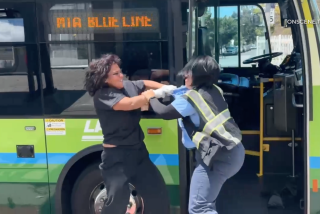I’m Now a Supportive Driver--Hear Me Moo
- Share via
My name is Agustin Gurza and I’m an aggressive driver.
Oh, yes, that’s hard to admit. I’d much rather blame all of you, fellow road warriors, for the frightful escalation of hostilities on our freeways. But if I continue to do that, I’ll never get well.
I have come to realize that your rude, risky and selfish driving habits are not really the problem. The problem all along has been my attitude toward your mean-spirited motoring. That’s what I need to work on: my gut reactions to being cut off, slowed down, squeezed out and pushed over in traffic.
I’m no longer going to fume at you for doing 40 in the fast lane. I’m not going to give you that “stink eye” of disapproval as I go around you. I’m not going to try to block your invasive lane change, even when I see you trying to sneak into that single car length between me and the car ahead. I’m not going to curse out loud and mention your mother when you brake abruptly, then whip across two lanes so you don’t miss your exit.
That’s the old me. This week, you’ll find a new Agustin Gurza behind the wheel. For I’ve been undergoing a driving personality make-over.
I’m not a defensive driver any more, presuming that everybody on the road is an idiot but me, although it may still appear that way. I am trying to become something revolutionary at the end of our first century of motoring.
I seek to be a supportive driver.
Yes, I want to find ways of cooling your commute, easing your egress and making your excursions less excruciating. In short, I want to help you get where you’re going.
Change is a challenge. But I am under the care of Dr. Driving, the nation’s top expert in the psychology of motorists. His real name is Leon James, professor at the University of Hawaii, a place not usually associated with freeways or aggression.
The make-over of motorists is his idea.
“The fuel that drives aggressiveness on the road is the false assumption that it’s the action of the other driver that makes us hostile,” explains James on his congested yet helpful Web site, www.aloha.net /~dyc/acts.html. “But the offending act . . . merely creates an opportunity . . . to express righteous indignation.”
Personally, that’s the only kind of indignation I’ve ever known. But James has heard it all. He’s tape recorded dozens of drivers as they vent: “This jerk just cut me off. . . . I don’t deserve to be pushed around. . . . Nobody gives me the finger and gets away with it . . . “
The good doctor prescribes a whole new way of driving with emotional intelligence, producing more appropriate responses. So instead of getting indignant, make up some reasonable excuses for the offending driver. (She’s about to have a baby. Or: His column is past deadline.) If nothing exculpatory comes to mind, make funny animal sounds. (Really, try it. Mooooo. Mooooo. See, makes you laugh.)
If all else fails, James suggests, think about being a saint.
That’s a stretch for some of us. Strangely enough, though, drivers don’t always have to act saintly to get along. The rules of the road are culturally defined, says James, who was born in Romania, schooled in Belgium, professionally trained in Canada and naturalized in the USA.
When he visited Rome, Bangkok and Tel Aviv, he was surprised at how frequently drivers yelled, cussed and gestured at each other without ever fighting. In L.A., the same behavior can get you killed.
“The norm of each country tells you how much you can get away with,” James said in a lively phone interview this week. On American roads, “you have to feel angry or else you feel like a wimp. But that’s a cultural response. Culture tells you that you have to get mad when somebody’s trying to take advantage of you.”
That helps explain a great motoring mystery: Why more drivers don’t kill each other in Mexico City, the capital of aggressive driving, where traffic often resembles a roller derby with vehicles vying for the head of the pack.
For all that, Mexicans usually take it in stride when aggressive drivers squeeze into tight spaces or make wild, unorthodox turns. Mexicans anticipate manic maneuvers and may even facilitate them so that crazy drivers can be on their way. (Anda, matate/”Go ahead, kill yourself.”) Supportive driving, sort of, south of the border.
It’s all a matter of tolerance. So I put my new insights to the test this week on the 405. When that white Caprice came speeding up beside me on the right, my impulse was to close the small gap ahead of me and prevent him from cutting me off.
Instead, I held back and let him drift into my lane as expected. He cruised uncomfortably there a while before moving over once more and speeding off in the fast lane. He was gone and I was mellow.
Thanks, Dr. Driving. I feel better already.
*
Agustin Gurza’s column appears Tuesdays. Readers can reach Gurza at (714) 966-7712 or online at agustin.gurza@latimes.com






